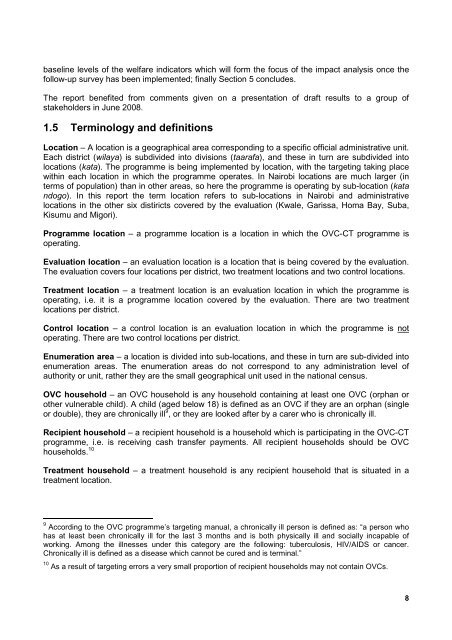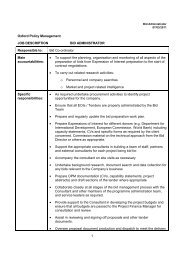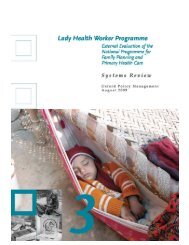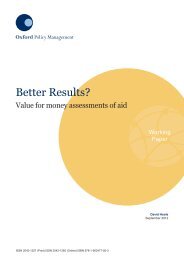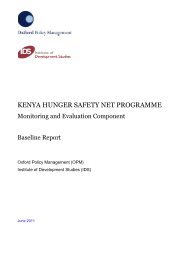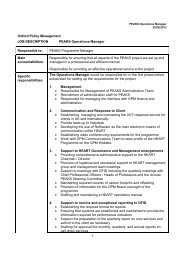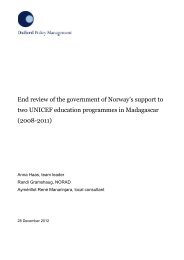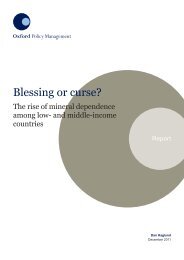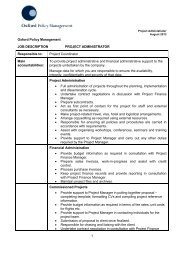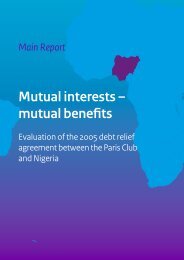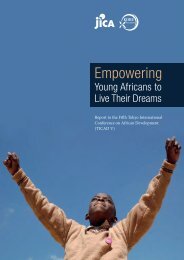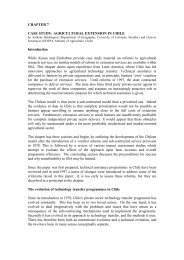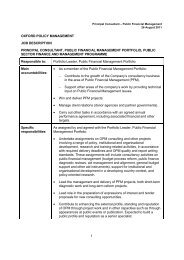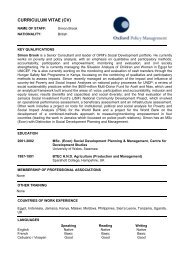Kenya OVC-CT Programme Operational and Impact Evaluation
Kenya OVC-CT Programme Operational and Impact Evaluation
Kenya OVC-CT Programme Operational and Impact Evaluation
You also want an ePaper? Increase the reach of your titles
YUMPU automatically turns print PDFs into web optimized ePapers that Google loves.
aseline levels of the welfare indicators which will form the focus of the impact analysis once thefollow-up survey has been implemented; finally Section 5 concludes.The report benefited from comments given on a presentation of draft results to a group ofstakeholders in June 2008.1.5 Terminology <strong>and</strong> definitionsLocation – A location is a geographical area corresponding to a specific official administrative unit.Each district (wilaya) is subdivided into divisions (taarafa), <strong>and</strong> these in turn are subdivided intolocations (kata). The programme is being implemented by location, with the targeting taking placewithin each location in which the programme operates. In Nairobi locations are much larger (interms of population) than in other areas, so here the programme is operating by sub-location (kat<strong>and</strong>ogo). In this report the term location refers to sub-locations in Nairobi <strong>and</strong> administrativelocations in the other six distiricts covered by the evaluation (Kwale, Garissa, Homa Bay, Suba,Kisumu <strong>and</strong> Migori).<strong>Programme</strong> location – a programme location is a location in which the <strong>OVC</strong>-<strong>CT</strong> programme isoperating.<strong>Evaluation</strong> location – an evaluation location is a location that is being covered by the evaluation.The evaluation covers four locations per district, two treatment locations <strong>and</strong> two control locations.Treatment location – a treatment location is an evaluation location in which the programme isoperating, i.e. it is a programme location covered by the evaluation. There are two treatmentlocations per district.Control location – a control location is an evaluation location in which the programme is notoperating. There are two control locations per district.Enumeration area – a location is divided into sub-locations, <strong>and</strong> these in turn are sub-divided intoenumeration areas. The enumeration areas do not correspond to any administration level ofauthority or unit, rather they are the small geographical unit used in the national census.<strong>OVC</strong> household – an <strong>OVC</strong> household is any household containing at least one <strong>OVC</strong> (orphan orother vulnerable child). A child (aged below 18) is defined as an <strong>OVC</strong> if they are an orphan (singleor double), they are chronically ill 9 , or they are looked after by a carer who is chronically ill.Recipient household – a recipient household is a household which is participating in the <strong>OVC</strong>-<strong>CT</strong>programme, i.e. is receiving cash transfer payments. All recipient households should be <strong>OVC</strong>households. 10Treatment household – a treatment household is any recipient household that is situated in atreatment location.9 According to the <strong>OVC</strong> programme’s targeting manual, a chronically ill person is defined as: “a person whohas at least been chronically ill for the last 3 months <strong>and</strong> is both physically ill <strong>and</strong> socially incapable ofworking. Among the illnesses under this category are the following: tuberculosis, HIV/AIDS or cancer.Chronically ill is defined as a disease which cannot be cured <strong>and</strong> is terminal.”10 As a result of targeting errors a very small proportion of recipient households may not contain <strong>OVC</strong>s.8


